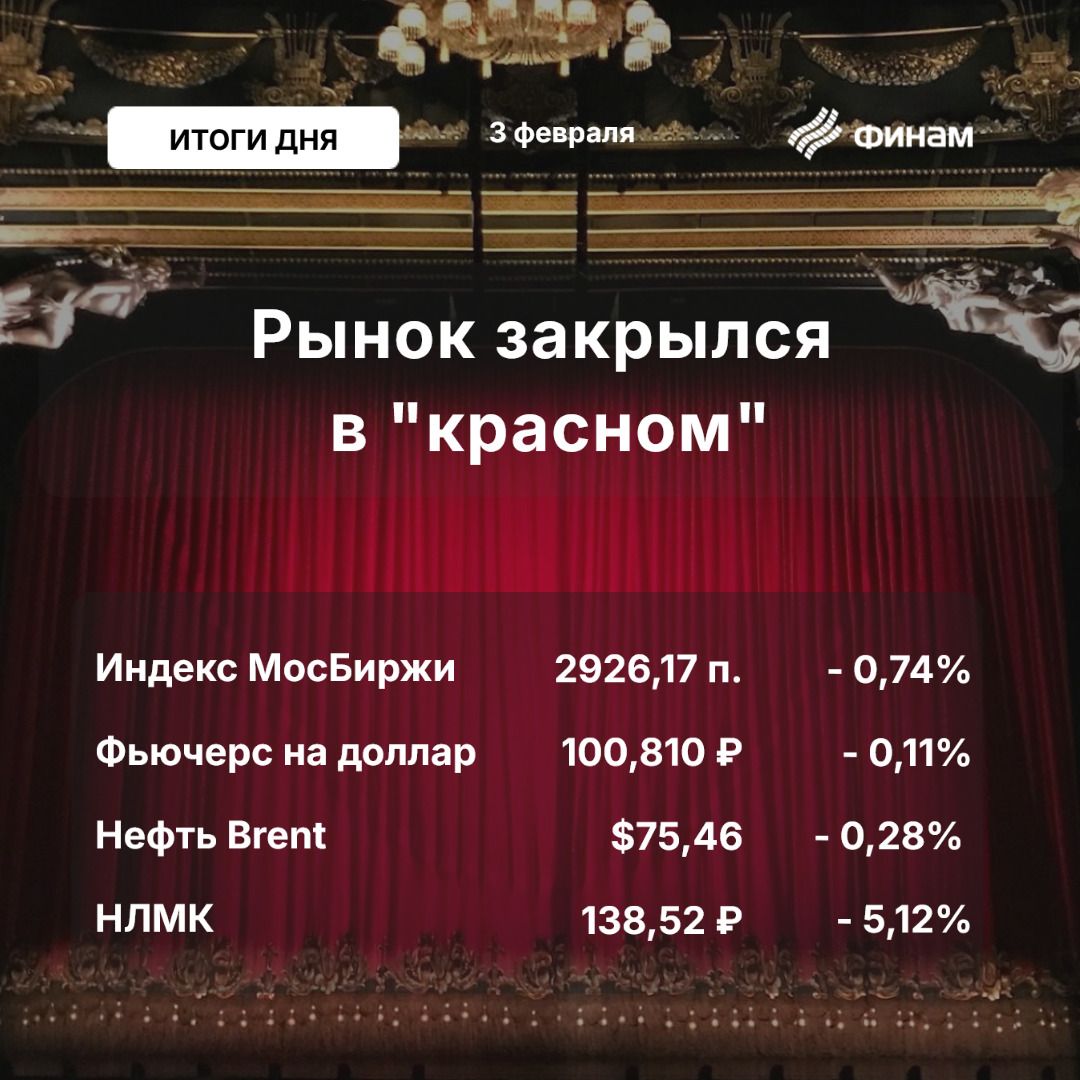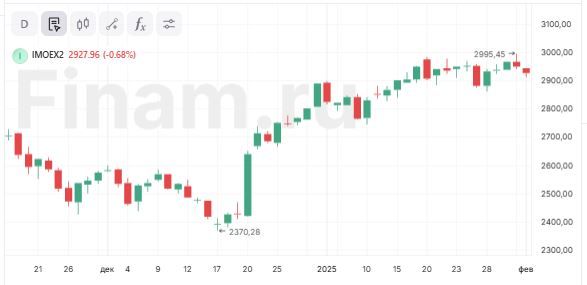The Russian stock market started February trading on a negative note, with the main session closing as the MOEX Index losing 0.7% to reach 2926.17 points, while the RTS index dropped by 2.86% to 922.33 points.
“The introduction of import duties for Canada, Mexico, and China by the United States triggered a negative reaction in stock markets worldwide, putting pressure on currency rates. Russian stocks and the ruble were not exceptions. Positive dynamics in oil prices helped to contain the correction,” explained Natalya Milchakova, an analyst at Freedom Finance Global.

Investor sentiment continues to be influenced by the complex geopolitical situation and potential sanction pressures.
“The MOEX Index continues to fluctuate in the 2890–3000 point range. In the next trading sessions, a small correction may continue. However, when the benchmark reaches a support level, it is likely to bounce off and attempt to surpass the 3000 point mark again,” said Ivan Ignat, an analyst at Finam.
The “Money Market” Fund from Finam is your path to stable passive income, even with small investments. Since its launch, the fund’s assets under management have exceeded 1 billion rubles. The fund’s potential return is 21% per annum. No extra expenses – no brokerage commissions. Withdraw your funds whenever you need them.
Leading the growth were the shares of Unipro (+4.4%) after the company presented strong operational results for 2024.
Rapidly rising gold prices (up to $28600 per ounce) lifted the shares of gold miners: UGK (+1.2%), Polius (+1.1%), Lenzoloto (0.6%).
Shares of Surgutneftegas (AO +0.4%), SUSH Holding (+0.4%), NMTP (+0.3%), Tatneft (+0.2%), Inter RAO (+0.2%) managed to end on a positive note.
The main underperformer was NLMK’s shares (-4.8%) following reports from the Ministry of Industry and Trade about the decline in steel production in Russia in 2024.
Severstal’s stock prices fell by 2.6%, reacting to the company’s board of directors’ recommendation to forego dividends in the fourth quarter of 2024.
Shares of Evrotrans (-1.1%) responded to the Moscow Exchange announcement that the listing level for Evrotrans’ securities will be changed from the first to the third as of February 5.
Closing the day in the red were NLMK (-4.8%), Mechel (AO -4.3%, AP -3.3%), VK (-4.2%), Raspadskaya (-3.1%), PIK (-3%), MMK (-3%), TMK (-2.7%).
Trading began in the negative today in Europe and the USA. The UK’s FTSE 100 index, concerned that US tariffs could ignite a global trade war, shifted to a decline. However, the stock market indicator’s dynamics slightly improved after Donald Trump suspended new tariffs on Mexico.
Oil prices continue to slide, falling below $76 per Brent barrel. Market participants are expecting an increase in oil demand in 2025. “Global agencies estimate growth in the range of 1-1.5 million barrels per day (b/d) or about 1.2% year-on-year growth, which corresponds to the average pace of the last 20 years,” commented Maxim Fedosov, a portfolio manager at Pervaya, specifying that the price forecast for 2025 is in the range of $70-80 per barrel.
Oil prices declined following the US halt on import tariffs against Mexico. It was announced that Mexican President Claudia Sheinbaum had agreed with President Trump to postpone tariffs on Mexico for a month. Similar relaxations may also apply to Canada. Today at 23:00 Moscow time, Trump and Trudeau will have a second discussion about mutual tariffs.
The market is being saved from a sharp decline by the OPEC+ alliance’s decision to keep production quotas at the current level, although agreement participants did not rule out the possibility of an early review of the deal’s terms. Russian Deputy Prime Minister Alexander Novak believes that behind the US calls for OPEC countries to lower oil prices may be a desire to increase their market share.
As of now, the futures for Brent crude oil are down by 1.2% – to $75.48 per barrel. Futures for Light crude oil are losing 1.8%, falling to $72.55 per barrel.
Today, the ruble managed to strengthen against the yuan but is losing ground against the dollar and the euro. “The ruble’s recent strengthening could have been due to preparations for tax and dividend payments, as well as seasonal factors. It can also be assumed that the ruble’s strength may be influenced by the increase in yuan supply in the money market at the end of last year, which was one of the reasons for the recent decline in yuan interest rates. It is possible that the ruble’s positions may remain strong in the short term, but in the future, the dollar’s exchange rate will stabilize in the 100-105 ruble range. This week, the dollar’s rate may remain in the 98-103 ruble range, the yuan – 13.3-14.1 rubles,” explained Natalya Vashelyuk, a senior analyst at Pervaya.
The yuan on the Moscow Exchange’s forex market lost 0.7%, dropping to 13.27 rubles. The nearest dollar futures rose by 0.14% to 100.97 rubles. On the interbank market, the dollar grew by 1.14% to 99.75 rubles, while the euro increased by 1.6% to 102.7 rubles.



